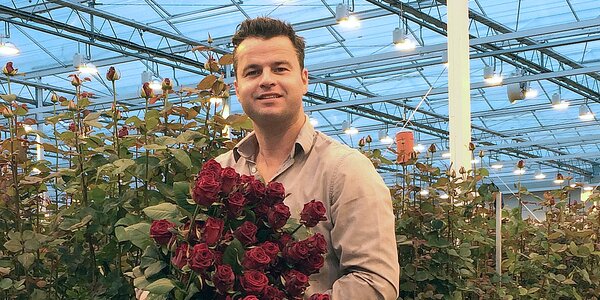Three seasons with ReduFlex Blue
Van den Ende Rozen has used ReduFlex Blue for three seasons. It worked very well for the first two years: the roses were considerably longer. In 2014 an unusual temperature dip in August disturbed the pattern.
Blue light slows down elongation which for cut flowers means stem length. On the other hand, less blue and proportionally more red light is good for length and production. ReduFlex Blue was developed with this in mind. The coating reduces the transmission of both blue light as well as infrared, the latter of which results in a large amount of heat remaining outside the greenhouse.
In 2012 Mardenkro proposed that Van den Ende Rozen tried the coating. The Dutch company has two nurseries in Monster, together totalling 6 ha, and it now grows Avalanche+ (white) and Red Naomi (red). “In 2012 we covered 1.5 ha with ReduFlex Blue and the rest with ReduHeat. Then we were growing the white variety Akito. We saw significantly more length under the blue-reflecting coating. We noticed it when the stems were in the water container and by the grading machine. The difference was about 3 to 4 cm compared with the roses that were grown under ReduHeat. In the summer, the length paid for itself,” says Sam van den Ende, who together with his brother and father owns the nursery.

Van den Ende Rozen
Red Naomi replaces Akito
A year later they replaced Akito with Red Naomi. Based on the positive experiences of the previous year they covered 3.3 ha with ReduFlex Blue and 1.1 ha with ReduHeat. “That was bit of a gamble,” he admits. “Red Naomi was a new variety for us and other colleagues hadn’t had any experience with the new coating. But because it all went so well with Akito I dared to try it. We discussed it with the crop advisor and the graphs showing the light spectrum measurements for this coating were convincing. You see a clear dip in blue light.”
The risk of bud burning in white roses is small; it’s a different story for red roses. Therefore they closed the screen at 700 to 800 Watt PAR light, depending on the temperature. By using this strategy the results with this variety were excellent too. “We were very satisfied with the young crop. The first year we could harvest quite quickly a good product with heavy stems. It was better than we expected and better than under ReduHeat. So again we were very satisfied with ReduFlex Blue.”
Cool summer
In 2014 it was somewhat different. Van den Ende used the same amount of coating and used the same screening strategy. “But this time ReduFlex Blue was no better than ReduHeat. Visually there was no difference. And the measurements too showed virtually no difference, according to the interim report. In 2014 we had a strange summer and August was a very cool month. I think it had something to do with that. Actually, the climate under ReduHeat was more pleasant last summer and production was even slightly higher,” he says.
Still positive
The conclusion after three years’ experience with ReduFlex Blue is for the most part positive. The effect of a coating is always dependent on the weather and last year - with fairly unusual circumstances in August – this was proven again. Van den Ende: “I mostly consider the positive aspects. You can use fewer buckets than with ReduHeat. In addition the coating doesn’t become transparent during roof spraying and it keeps the heat outside.”